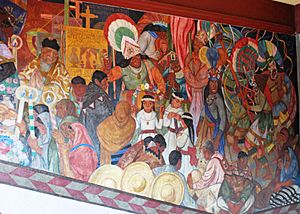Fernando Leal (artist) facts for kids

Fernando Leal (born February 26, 1896 – died October 7, 1964) was an important Mexican painter. He was one of the first artists to join the Mexican muralism movement in the 1920s. After seeing one of his paintings, the Secretary of Education, José Vasconcelos, invited Leal to paint a mural. This mural became Los danzantes de Chalma. Leal also painted a large mural about Simón Bolívar and religious murals, like those at the chapel dedicated to the Virgin of Guadalupe.
Contents
Life of Fernando Leal
Fernando Leal was born in Mexico City on February 26, 1896. He first studied art at the Academy of San Carlos. Later, he went to the Escuela al Aire Libre de Coyoacán, where he learned from Alfredo Ramos Martinez. He was friends with other famous artists like Gabriel Fernández Ledesma and Ramón Alva de la Canal.
Leal passed away on October 7, 1964. His son, Fernando Leal Audirac, also became a well-known Mexican painter.
Fernando Leal's Art Career

Leal was one of Mexico's first muralists. This art movement began in the 1920s. In 1921, José Vasconcelos, who was the Secretary of Education, visited Leal's art school. He saw Leal's painting called Zapatistas at Rest. This painting showed indigenous persons in a realistic way, using European art styles. Vasconcelos liked it and asked Leal to paint a mural at a school.
Leal joined other famous artists like Diego Rivera and David Alfaro Siqueiros. They were asked by the government to create art after the Mexican Revolution. Their goal was to help build a "new sense of Mexican identity."
Famous Murals by Leal
The first mural Leal painted was Los danzantes de Chalma. It is located at the Escuela Nacional Preparatoria, which is now the San Ildefonso College. Leal chose the topic himself. This mural was made using a special technique called encaustic. It shows a traditional dance from the town of Chalma. The painting mixes Catholic and indigenous traditions. It looks very natural, but with simpler shapes, similar to Post-Impressionist art.
Another famous work is a fresco at the Anfiteatro Bolívar. He painted this from 1930 to 1933. It shows the life of Simón Bolívar, a hero who fought for freedom in South America. In this mural, Leal mixed history with imagination. The main part shows Bolívar on horseback. The bottom part shows the struggles for freedom. It also features indigenous people who inspire the hero.
Leal also painted murals that no longer exist. In 1927, he painted murals for a health department, but they were later destroyed. He also painted a mural in Panama called Neptuno encadenado (Neptune chained). This painting criticized imperialism. In 1943, he painted two panels at the train station in San Luis Potosí. These were called El triunfo de la locomotora (The triumph of the locomotive) and La edad de la máquina (The age of the machine). The first one showed the difference between old and new ways of travel.
In 1949, Leal painted seven murals at the Tepeyac chapel. These frescos tell the story of how the Virgin of Guadalupe appeared.
Teaching and Advocacy
Fernando Leal taught painting at the Academy of San Carlos. In 1927, he became the director of the Centro Popular de Pintura. This center aimed to make art available to everyone, especially working-class people. In 1952, he became part of the Ministry of Culture. He worked to protect artists' rights in 1959. He also directed the Escuela al Aire Libre de Coyoacán.
Leal helped start a group called ¡30-30!. This group published a magazine that disagreed with traditional art ideas. Leal also wrote about art sometimes. In 1952, he published a book called El derecho de la cultura (The right of culture).
His paintings can be seen in the Museo de Arte Moderno. These include El hombre de la tuna (The man of the prickly pear) and Campesinos con sarape (Farm workers with sarape). He was also good at making wood engravings.
Fernando Leal's Artistic Style
Leal is most famous for his murals. But he also created engravings, lithographs, and paintings on canvas. He was one of the first Mexican muralists to use many different art techniques. He often made small test versions of his work. This helped him plan his large murals better. His murals often used encaustic painting. This technique created rich, clear colors.
He was known for his use of color. He also used images from Mexican rural life and popular culture early on. His art often showed traditional customs and religious figures. He was one of the first to use indigenous themes in his large-scale works. His style combined different shapes, similar to Saturnino Herrán. His art avoided allegory and was part of the Mexican realist painting style. His artistic style was a mix of Baroque and Classic art, but with bright colors.
See also
 In Spanish: Fernando Leal para niños
In Spanish: Fernando Leal para niños
- Mexican Muralism
- Fresco
- Encaustic Painting

